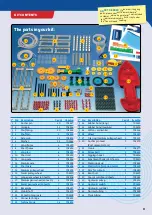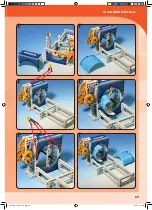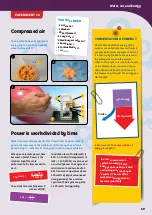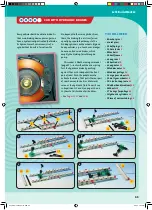
GOOD TO KNOW
45
Air and Water in the Flow
The pressure in the direction of
flow is also called dynamic
pressure, because it arises with
dynamics, or the force of
movement. In tubes, there is
always also something called
static (resting) pressure, which is
a product of the difference in
pressure between the entrance to
and exit from the tube.
Dynamic pressure is measured
against the stream, static
pressure in the stream. When the
liquid is resting, there is only
static pressure, and the dynamic
pressure is equal to zero. When
movement starts, dynamic
pressure rises and static pressure
simultaneously drops.
That also applies in reverse. In a
uniform current, in any case, the
sum of the two pressures is
always the same.
Because the speed of the water increases in the narrow part of a tube,
the pressure also increases in the direction of flow. But an increase in
pressure also means an increase in force per unit of area and, thus, an
increase in the distance the narrower stream of water can shoot.
Pressure in currents
THE FLOW EQUATION
If you multiply the large cross-
sectional area (A1) by the
corresponding velocity (v1), the
product is the same as when you
multiply the small cross-sectional
area (A2) by the velocity there (v2).
This equation is called the flow rate
equation or continuity equation:
1 N = 1 kg · m
s
2
1 Pa =
1 bar = 1,000 hPa
1 N
1 m
2
1 W =
1 J
1 s
P (Pressure) =
F
1
: A
1
= F
2
: A
2
p
1
: p
2
= V
2
: V
1
p
1
: p
2
= T
1
: T
2
or: p · V = constant
(only valid when T = c
onstant)
F
1
· L
1
= F
2
· L
2
p
1
· V
1
= p
2
· V
2
A
1
· v
1
= A
2
· v
2
Load · Load arm = Force · Force arm
F ( Force)
A (Area)
P (power) =
W (work) = F (force) · s (dist
ance)
W (work)
t (time)
Fd = Cd · A · · v
2
2
P =
= 2
= 2 Pa
10 N
5 m
2
N
m
2
P =
= 200,000 Pa
100 N
0.0005 m
2
P =
= 16,000 Pa or 16 hPa or 1.6 bar
4 N
0.00025 m
2
or
= constant
=
p
1
· V
1
T
1
p · V
T
p
2
· V
2
T
2
Fd = 0.4 · 2 m
2
· 1.23 kg/m
3
· (40 m/s)
2
2
Fd = 0.4 ·
= 787.2 N
3936
2
kg · m
s
2
Total energy
Work yielded
Friction
Slip-
stream
Turbulence
Panel
Cylinder
Teardrop
Turbulence
Toggle switch center
Stop in all directions
Supply
Toggle switch
left
Toggle switch
right
Total Pressure
Dynamic
Pressure
Static Pressure
F1
F2
F2
L1
L2
F1
L1
L2
One-armed
lever
Two-armed
lever
Lift
Aileron
(wing flap)
Rudder
Pitch elevator
Horizontal stabilizer
Stagnation point
Lift through low pressure on the
upper side of the wing
Vertical stabilizer
(vertical tailfin)
Wing
Aileron (wing flap)
Gravity
Wing
Center of
mass
Center of lift
Stagnation point while gliding
A1
V1
V2
Equal quantities of water
A2
H1
H2
Buoyancy B =
Hydrostatic pressure 1 –
Hydrostatic pressure 2
B
Stagnation point
Lift through low pressure on the
upper side of the wing
Additional lift through pressure
on the underside
Pressure on the underside
Total energy
Work yielded
Friction
Slip-
stream
Turbulence
Panel
Cylinder
Teardrop
Turbulence
Toggle switch center
Stop in all directions
Supply
Toggle switch
left
Toggle switch
right
Total Pressure
Dynamic
Pressure
Static Pressure
F1
F2
F2
L1
L2
F1
L1
L2
One-armed
lever
Two-armed
lever
Lift
Aileron
(wing flap)
Rudder
Pitch elevator
Horizontal stabilizer
Stagnation point
Lift through low pressure on the
upper side of the wing
Vertical stabilizer
(vertical tailfin)
Wing
Aileron (wing flap)
Gravity
Wing
Center of
mass
Center of lift
Stagnation point while gliding
A1
V1
V2
Equal quantities of water
A2
H1
H2
Buoyancy B =
Hydrostatic pressure 1 –
Hydrostatic pressure 2
B
Stagnation point
Lift through low pressure on the
upper side of the wing
Additional lift through pressure
on the underside
Pressure on the underside
Physics Pro 2014 Part 1.indd 45
8/1/14 1:27 PM






